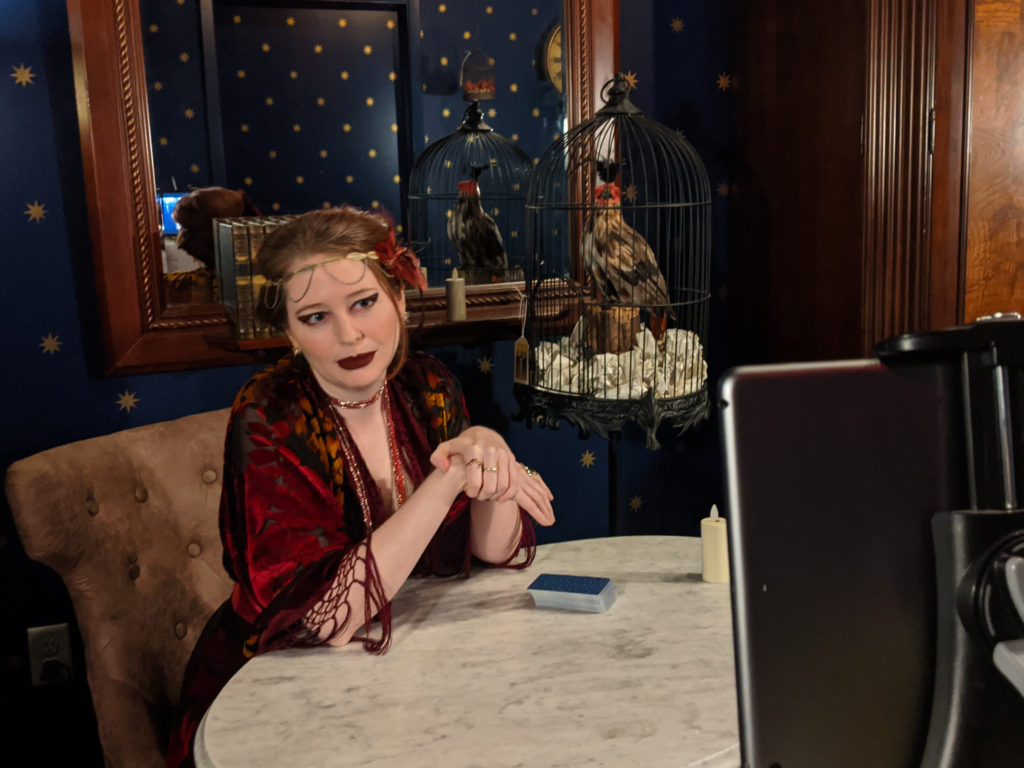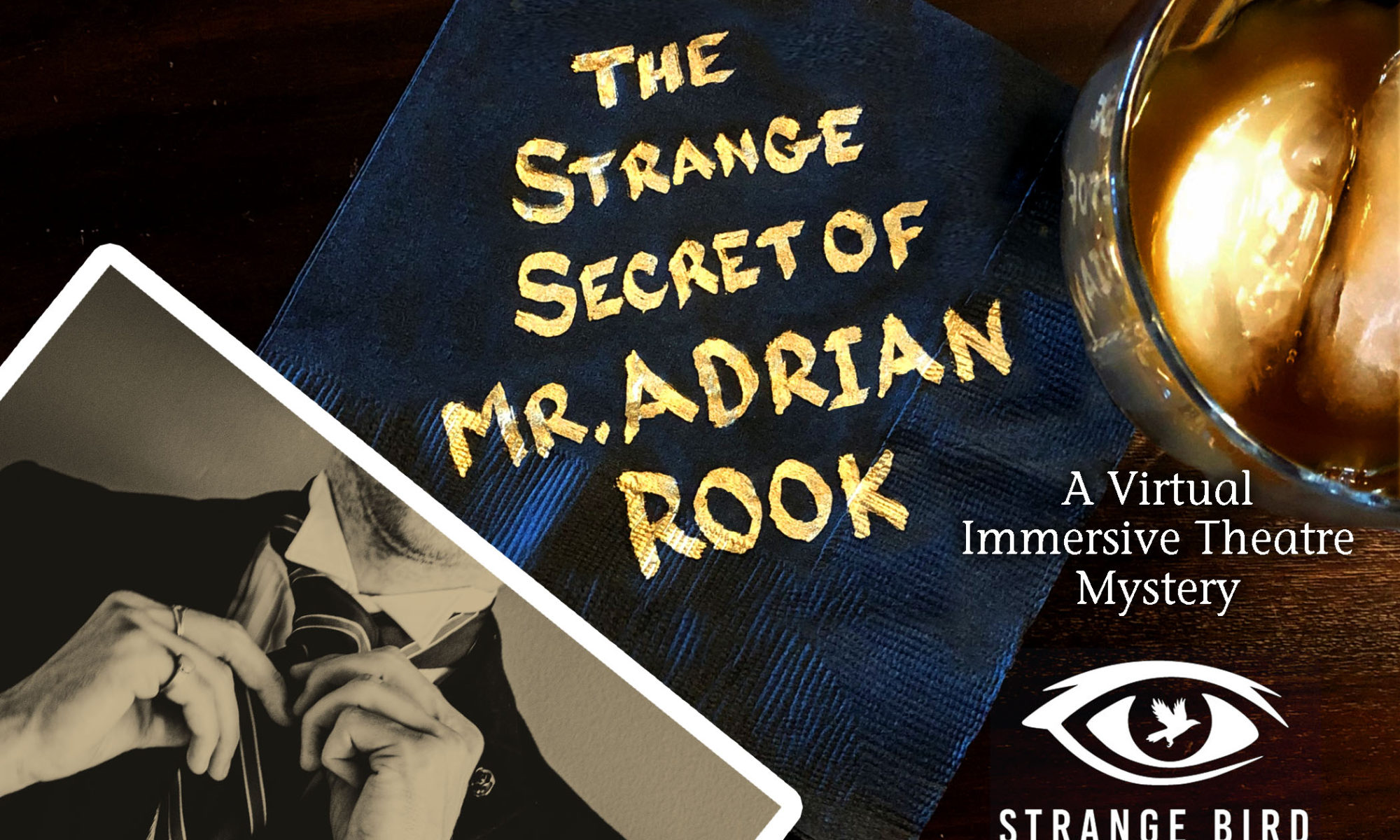In the face of an ongoing pandemic, Strange Bird Immersive has elected to keep our doors closed. To help us make rent, we’ve pivoted to creating virtual experiences.
I am eager to report that Zoom can indeed deliver the thrill of immersive theatre.

We started with Zoom Tarot Readings with Madame Daphne, a new fifteen minute one-on-one experience with a character we know, with a skill we could spotlight.
This Saturday night, we’re opening The Strange Secret of Mr. Adrian Rook. It’s an all-new experience that explores the Strange Bird Immersive story: 90 minutes, 6 actors, and a strong dose of magic.

Along the way, we’ve learned a thing or two about how to make the most of virtual experiences. So here’s a list of do’s and don’ts to jump start your own creation.
DON’T UNDERSELL IT
You’ve created something. You’ve invested time and money. Even if you’re not paying rent on 3,400 sqft, you still have expenses. Just because your experience is virtual does not mean it has no value. Charge for it. Trust me: no one will remember in a six months when they’re looking for an escape room that, “Wasn’t that free game we played one night from Trapopolis fun?”
Don’t forget about perceived value. If you sell your production for free or $5 or $10, that suggests I shouldn’t expect much. You’ve set my expectations low. Charge $20, $30, $40, and that sounds much more to me like a real experience, something to look forward to, something to book now.
DO DELIVER PRODUCTION VALUES
Everyone is tired of looking at people’s living rooms. Deliver the same aesthetic WOW! that you would if they were in-person. Give them something beautiful to look at in the first five seconds. Consider costume, makeup, set and light. Production values establishes your show as not-your-everyday-Zoom.
Visuals are arguably the most powerful tool we have in the immersive entertainment arsenal. People remember visuals. They don’t remember what they heard half so well. Movies get this. And guess what we’re making now? Give them visual memories.
Sets are easier than ever before over Zoom, so make a few. Position the camera just right, and you don’t even have to dress the whole wall!

DO TEST EQUIPMENT
Gather your devices in one place, and test out cameras and computer processing side-by-side. See what camera looks awful, what computer runs a delay. The iPad has the best camera…? Okay, go for it!

Test mics. Test the sound in the space. Test the internet, and test it again. What’s that weird buzzing? Find out. Figure out the camera angle—you can have a lot of fun with the camera angle! And test the lighting. Prioritize the face.
I am so, so sorry, but you’re a videographer now. Learn those skills. Those skills mostly involve mastery of equipment.
DO INVEST IN EQUIPMENT
You don’t need to spend a lot to boost your set-up to a more professional level. Most likely you’ll want to buy lighting. You want photography light for Zoom—architectural light won’t do. We bought a few photography light kits.
DO CREATE FOR THE MEDIUM
Strange Bird briefly considered offering The Man From Beyond as an avatar-led Zoom escape room. There were many problems with adapting it, but the number one problem was that our puzzles are all tactile. They’re about discovering the physical item. We have only one puzzle that requires a notepad. Wouldn’t tactile puzzles become frustrating in the avatar medium?

So we decided to save our award-winning experience for what it was designed for: in-person play.
When we wrote both Tarot Readings and The Strange Secret of Mr. Adrian Rook, we created with Zoom in mind. For all its faults, Zoom is the platform of the moment and requires the least on-boarding of guests. We leaned into the medium and built experiences that worked with that tool rather than against it. Our engagements flow easily, and our puzzle was built for the Zoom style of solving.
We also have a really cool moment in Tarot Readings where we engage with the platform’s features. It’s a WOW moment—from within Zoom. Weird and wonderful. I’ve also heard of other immersive experiences using Zoom’s breakout rooms to great effect. Explore what the medium can do.
The most satisfying virtual experiences are at home on the platform—they would not easily translate to an in-person experience.
DON’T PRETEND RECORDED VIDEO IS LIVE
It’s disappointing to try to engage with an actor only to discover they’re a video. In-person escape rooms do this all the time. It sucks over virtual, too, perhaps even more. We’re so hungry to connect.
DO JUSTIFY LIVE ENGAGEMENT
If you’ve got an actor or an avatar in the experience, use them to your most entertaining advantage. Actors are your best special effect. I’ve long considered them the fast-pass to immersion, as players have to engage with the imaginary world to engage with the actor at all. Actors make the experience dynamic. If you’ve got them, give them more than a puzzle to deliver or a two-minute scene.
Immersive theatre has the edge on traditional theatre right now. Presenting live theatre over Zoom makes no sense to me if there’s no engagement. Why not film the best version of the production, edit it, and put that out? It’d be better for the audience. Not so with immersive theatre: ours is a genre where you just have to be there. So engage, engage, engage. Keep alive the fire of live performance.
DON’T MUTE EVERYBODY, DO USE SPOTLIGHT
Tarot Readings feels like a real conversation—because it is. We make it as natural as possible.

For Strange Secret, we thought 8 unmuted guests plus one leading actor would overwhelm the scene. So we tried “mute all.” You should see the beta tapes. All six actors fumbling through the clunky process of unmuting and muting guests just to ask them a simple question or two. It slaughtered the fun.
Then we discovered a special Zoom feature: SPOTLIGHT. Once the host admits guests to a meeting, the host can spotlight their video, so that the video doesn’t randomly prioritize a laughing guest or someone’s barking dog. We could lock the video on the actor.
So we went with unmute. Just like with a real immersive, guests gain an instinct for when to speak and when not, and it makes the “being there” much more authentic and the engagements more natural. Plus, there were no technical problems. At least with 9 people. More than that…maybe you’d be pushing it.
DON’T UNDERSCORE YOUR VIDEO
We tried working with underscore, but the only way it doesn’t clip in and out over Zoom is if everyone else is on mute. So there goes our in-house style of scoring everything.
DO LOOK INTO THE CAMERA
This is the best trick on this list. No matter where the camera is positioned, if you look straight into it, you’ll make eye contact with your guests. Can’t see it easily? Outline it with tape. Look at the camera as much as possible. It combats Zoom fatigue for your guests like nothing else.

DO HIGHER ENERGY
Siobhan O’Laughlin, immersive theatre superstar and veteran Zoom performer, put it to us thus: “If your energy is 10, that translates to a 6 over Zoom.” Performances need way-higher-energy in this medium.
DOn’T USE PAUSES
Dramatic pauses in-person build tension; over Zoom, they kill the scene. Pause as little as you can. Keeping them in your world requires more effort than before.
DON’T FORGET TO BETA TEST
Just like an in-person interactive experience, you’ll want to beta test. How people engage will surprise you. Does it work? Tweak it until it does. Record the experience, and review it closely. Invite feedback afterwards, and listen. I can’t tell you how much beta feedback fundamentally changed Strange Secret for the better.
DO GET CREATIVE
I love constraints. They fuel my creativity. We’re under a ton of constraints right now, and no, I don’t expect virtual experiences to replace the income we’re losing from closing our primary business. And yet…this is a wonderful moment to branch out, to experiment, to test and fail and test again. I hear audiences are more forgiving then ever. They get it. They want to be somewhere else, do something else, see something NEW.
Let’s give them something new!



Congrats on such a creative and innovative adaptation of your craft, Haley and Cameron! So glad to see Strange Bird rolling with the punches and staying aloft. You guys are an inspiration. I look forward to seeing you soon in that weird, wonderful space between pixels and screens. 😉
These insights are awesome.
We’ve been running interactive zoom games at Buckbuck Games and have had similar findings, especially with our adventure games.
So much more to be found as new features emerge – constantly rolling with it!
Try using share computer audio for underscoring. I haven’t used it for this purpose, but I think that should eliminate the clipping issue. Click on share screen, then advanced at the top of the window, then “music or computer sound only”
That will also allow the music to continue to play when the actor is muted.